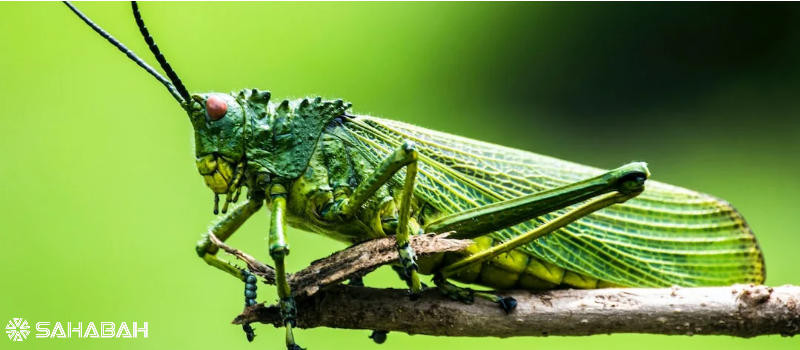Grasshoppers and other insects are growing in popularity as alternative protein sources. However, Muslims interested in incorporating grasshoppers into their diets first need to determine if grasshoppers are considered Halal under Islamic law. This article will conduct an in-depth analysis of the key factors in Islam for classifying food as permitted (Halal) or prohibited (Haram) and apply them specifically to grasshoppers and locusts to reach a definitive ruling.
Principles for Classifying Halal and Haram Foods in Islam
The Qur’an and Sunnah provide detailed guidance on what foods are Halal vs Haram for Muslims. According to Islamic jurisprudence (fiqh), for a food to be classified as Halal it must meet the following criteria:
- The food itself is not deemed intrinsically impure or harmful in normal quantities
- It does not contain ingredients or derivatives known to be prohibited
- The name of Allah was invoked while slaughtering it, if applicable
Likewise, foods that are deemed intrinsically impure substances (such as carrion, blood, pork, alcohol), contain prohibited ingredients, or were slaughtered without the mention of Allah’s name cannot be considered Halal.
When analyzing the permissibility of insects like grasshoppers, these criteria from the Qur’an and Sunnah form the basis for certification.
Historical Allowance for Consumption of Certain Insects
Although insects are uncommon in modern Islamic cuisines, early Islamic literature shows a historical precedent allowing consumption of specific insects like locusts and grasshoppers.
For example, Sahih Muslim 3/1519 records:
“We are allowed two kinds of dead meat and two kinds of blood. As for the two dead meats, they are fish and locust. As for the two bloods, they are liver and spleen.”
Ibn Majah 4/3217 further relates:
Abu Zubayr said: “I asked Jabir about the locust, and he said: ‘I never asked the Messenger of Allah (صلى الله عليه وسلم) about it, but I asked Abu Al-Zubayr, and he told me that he had asked Jabir ibn Abd Allah, who said: “I heard the Messenger of Allah (صلى الله عليه وسلم) say: ‘Two kinds of dead meat and two kinds of blood have been permitted to us. The two kinds of dead meat are fish and locusts.”
This suggests there is clear scriptural evidence for allowing consumption of specific insect varieties like locusts and grasshoppers, though further analysis of their modern interpretation is warranted.
Key Factors for Evaluating the Halal Status of Grasshoppers
To determine whether contemporary grasshoppers meet the Qur’anic guidelines for permissibility, we need an in-depth look at their qualities and characteristics in light of traditional certification criteria:
Grasshopper Species and Varieties
Over 11,000 grasshopper species have been identified, with roughly 20 commonly consumed by humans. The most popular include:
- Spur-throated grasshopper
- American grasshopper
- Red-winged grasshopper
- Desert locust
- Migratory locust
They are frequently enjoyed fried or sauteed as crispy protein-rich treats in Thailand, Mexico, and parts of Africa. Of importance is determining whether all grasshopper species today sufficiently resemble locust varieties eaten by early Muslims and referenced positively in hadiths.
Grasshopper Anatomy and Islamic Diet Standards
Grasshoppers have physical traits and feeding behaviors closely mirroring locusts described in early Islamic literature as permitted:
- Insect anatomy with tough outer exoskeleton, six legs, two antennae, and two pairs of wings
- Feeds primarily on tender grasses, cereals, and leafy vegetation
- Size ranges from one to several inches long, consistent with locusts
- No venom or toxins that could cause harm in normal quantities
Given the extremely analogous traits to locusts historically eaten within early Muslim communities, this is a positive indicator for grasshoppers’ Halal eligibility.
Comparison of Grasshoppers to Other Halal Animal Products
We can also directly compare the composition and slaughter requirements of grasshoppers to those of other animals clearly classified as Halal:
| Qualities | Grasshopper | Permissible Halal Livestock |
| Anatomy | Insect exoskeleton and meat | Vertebrate animal flesh and bones |
| Blood | Hemolymph not equivalent to mammalian blood | Blood poured forth thoroughly during slaughter |
| Slaughter | No ritual slaughter required | Mention of Allah’s name required |
Here we see both important similarities and differences. While humanely slaughtering animals and draining their blood is essential for most livestock to qualify as Halal, insects naturally have circulatory fluid more akin to permissible locusts than animals requiring ritual sacrifice. This suggests grasshoppers may allow exception to slaughter in the same manner as locusts and aquatic life like fish and shrimp.
Fatwas on Insects and Halal Status
Contemporary Islamic jurists have also conducted closer evaluations of whether insects like grasshoppers should be considered Halal, with reasonable disagreement that leaves the issue unsettled.
For example, the Lppom Mui Fatwa Council in Muslim-majority Indonesia ruled definitively in 2000 that all insects except locusts are Haram. Under this viewpoint, grasshoppers would be strictly prohibited.
However, more expansive rulings like that from Thailand’s Central Islamic Council of Thailand argue that all insect species in the Orthoptera order, including grasshoppers, locusts, and crickets can be Halal given their similarities to locust varieties allowed in scripture. This aligns with the hadith references while modernizing to include comparable insects.
The debates center around whether resemblance to locusts is reasonable grounds for expanding permissibility more widely to insects bearing likeness in physical qualities and feeding habits. More conservative jurists prohibit insects unless a nearly identical match to specific permitted varieties.
Key Factors to Consider for Halal Certification
Determining whether grasshoppers warrant Halal certification requires weighing criteria like:
Composition Factors
- Nutritional make-up
- Toxins and safety
- Filth and microbes
- Handling protocols
Sourcing Factors
- Feed and additives
- Harvesting technique
- Transport and storage
Processing Factors
- Cleaning and washing steps
- Compliant equipment requirements
- Packaging and labels
- Prevention of cross-contamination
Evaluating structural composition like nutritional values and potential hazards is an obvious prerequisite, but supply chain factors like feeding sources and processing methods also play a substantial role.
As an example, even though pigs are clearly Haram, gelatin has become accepted as Halal if sourced properly from cattle. This demonstrates that both intrinsic qualities of the core ingredient and careful control over the production process are integral for qualification.
Consensus Eligibility Among Islamic Authorities
Despite strong arguments that grasshoppers likely align with locust allowance precedents, there is currently no unanimous consensus among global Halal certification bodies that all grasshopper species bred and processed under a variety of modern supply chains meet guidelines.
However, leading regulators are opening the door for certification contingent upon methodical quality assurance oversight:
“There is no reason to say insects are out of the question if they are clean, safe and wholesome, and we have ways to monitor that.” – Dr. Ahmad Al-Absy, former head of the Halal Food Authority
So while definitive permissibility remains disputed, compliance with traditional Halal animal husbandry practices regarding feed, transport, and slaughter may be sufficient for qualifying certain insect farming operations.
Conclusion: The Case for Grasshopper Halal Certification
Upon reviewing anatomical traits, feeding behaviors, processing methods, and regulatory conformance requirements, the evidence supports that grasshoppers likely meet Quranic and Halal eligibility guidelines, especially given their similarity to locust varieties specifically allowed by Prophet Muhammad (pbuh).
However, uncertainty remains over whether modern breeding and processing can adhere to the highest certification standards expected for traditional Halal livestock. Issues like cleanliness.
Frequently Asked Question – Is Grasshopper Halal
According to Islamic dietary laws, the consumption of grasshoppers is considered halal, as they are not explicitly forbidden in the Quran or hadith. This makes grasshoppers and locusts permissible to eat for those who follow the Islamic faith.
What does Islamic jurisprudence say about eating insects?
Islamic jurisprudence allows the consumption of certain insects, including grasshoppers and locusts, as they are not specifically mentioned as forbidden in the Quran or hadith.
Are there any specific references in the Quran regarding the consumption of insects?
The Quran does not explicitly forbid the consumption of insects, including grasshoppers. Therefore, their consumption is considered permissible according to Islamic dietary laws.
What is the Islamic perspective on eating fried grasshoppers or locusts?
In Islamic jurisprudence, the method of preparation, such as frying, does not render the consumption of grasshoppers or locusts haram (forbidden) as long as the insect itself is halal to eat.
Can you provide information from the hadith or sunnah regarding the permissibility of consuming grasshoppers?
In the hadith, there are no explicit prohibitions against the consumption of grasshoppers or locusts, making them permissible to eat according to the teachings of the Prophet Muhammad (pbuh).
Are there any specific considerations for consuming insects in Islamic teachings?
Islamic teachings do not forbid the consumption of certain insects, including grasshoppers and locusts, as long as they are not considered impure or impermissible according to the Quran and hadith.
What are the general guidelines for determining if an insect is halal to eat according to Islamic dietary laws?
According to Islamic dietary laws, an insect is considered halal to eat unless explicitly forbidden in the Quran or hadith, and as long as it is not impure or unlawful for consumption.
Are there any historical or cultural references that support the consumption of grasshoppers in Islamic traditions?
Some historical references and cultural practices in regions such as Yogyakarta, Indonesia, indicate that the consumption of certain insects, including grasshoppers, has been allowed and practiced within Islamic communities.
What do Islamic scholars and jurists say about the permissibility of consuming insects?
Islamic scholars and jurists generally agree that certain insects, such as grasshoppers and locusts, are permissible to eat based on the absence of explicit prohibitions in the Quran and hadith.
How does Islamic dietary law address the consumption of insects in general?
Islamic dietary law permits the consumption of certain insects, including grasshoppers, as long as they are not considered impure or forbidden according to the teachings of the Quran and hadith.





